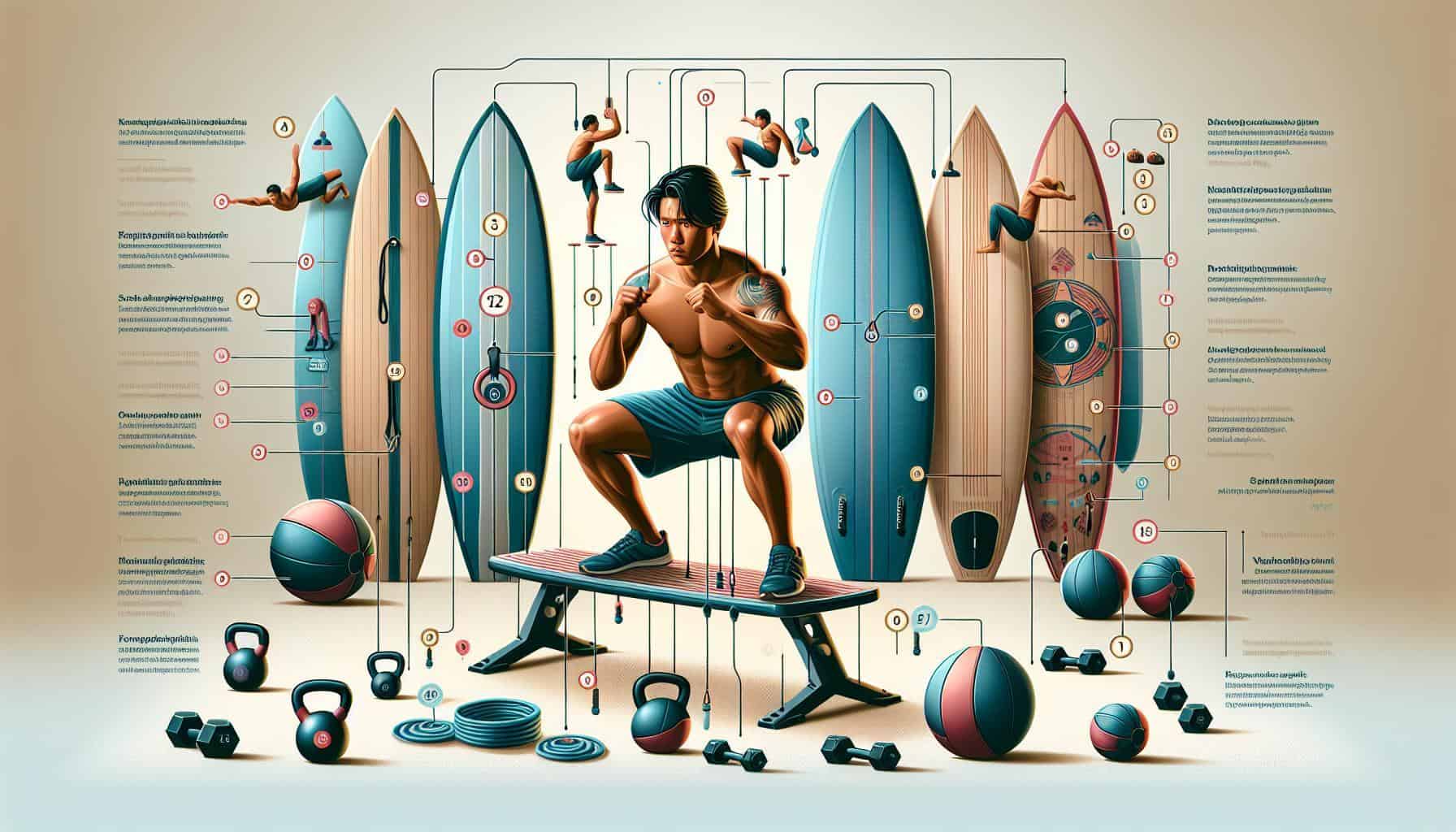Boost Your Wave Game: Strength Training For Surfing
Surfing’s not just about catching waves; it’s a full-body workout that challenges even the fittest athletes. You’ve likely discovered that traditional gym routines don’t quite cut it when you’re paddling against the tide. That’s because surfing demands a unique blend of muscle endurance and agility that’s honed through specialized strength training.
Designing a surf-specific workout can seem daunting, but it’s all about simulating the ocean’s demands on dry land. You’ll want to focus on the small muscles in your back and shoulders, vital for those long paddling sessions. And don’t worry, you won’t need heavy weights to build the endurance these muscles require.
Whether you’re a seasoned surfer or just starting, understanding the right way to train can make all the difference. You’ll be able to stay out longer, catch more waves, and most importantly, have more fun. Let’s dive into how you can build a surf strength training program that’s tailored just for you.
Why Strength Training is Important for Surfing
Strength training for surfing isn’t just about enhancing performance; it’s a pivotal component for your safety and overall surf experience. In a sport where you’re pitted against the unpredictability of the ocean, having a strong, well-conditioned body could be the difference between catching the wave of the day or taking a gnarly spill.
Explosiveness, balance, core stability, and endurance are the cornerstones of a surfer’s physique. These aren’t qualities that develop solely through time spent in the water; rather, they’re forged through focused strength training. Specifically designed surf workouts can substantially reduce your risk of injury by fortifying the muscles and joints that are most susceptible to the stresses of surfing.
For example, the explosive power needed to pop up on your board comes from core and lower body strength. Imagine the countless maneuvers you execute while riding a wave – quick direction changes, deep carves, and sudden snaps. All these moves require a profound level of muscular control and power that only targeted strength training for surfing can offer.
Moreover, your endurance in paddling, which dictates how long you can stay out in the water and how many waves you can catch, hinges on the conditioning of your back, shoulders, and arms. Building muscle endurance doesn’t necessarily mean bulking up. It’s about crafting a resilient body through consistent, surfing-centric exercise routines.
- Prioritize exercises that mimic the demands of surfing
- Develop explosive power for critical maneuvers
- Enhance core stability for better board control
- Increase overall muscle endurance for prolonged surf sessions
Neglecting these aspects in your training regimen will leave gaps in your surf skill set. By embracing strength training tailored for surfing, you’ll ensure that you’re not just a passenger on your board but a commanding presence on the wave.
The Benefits of Surf-Specific Training
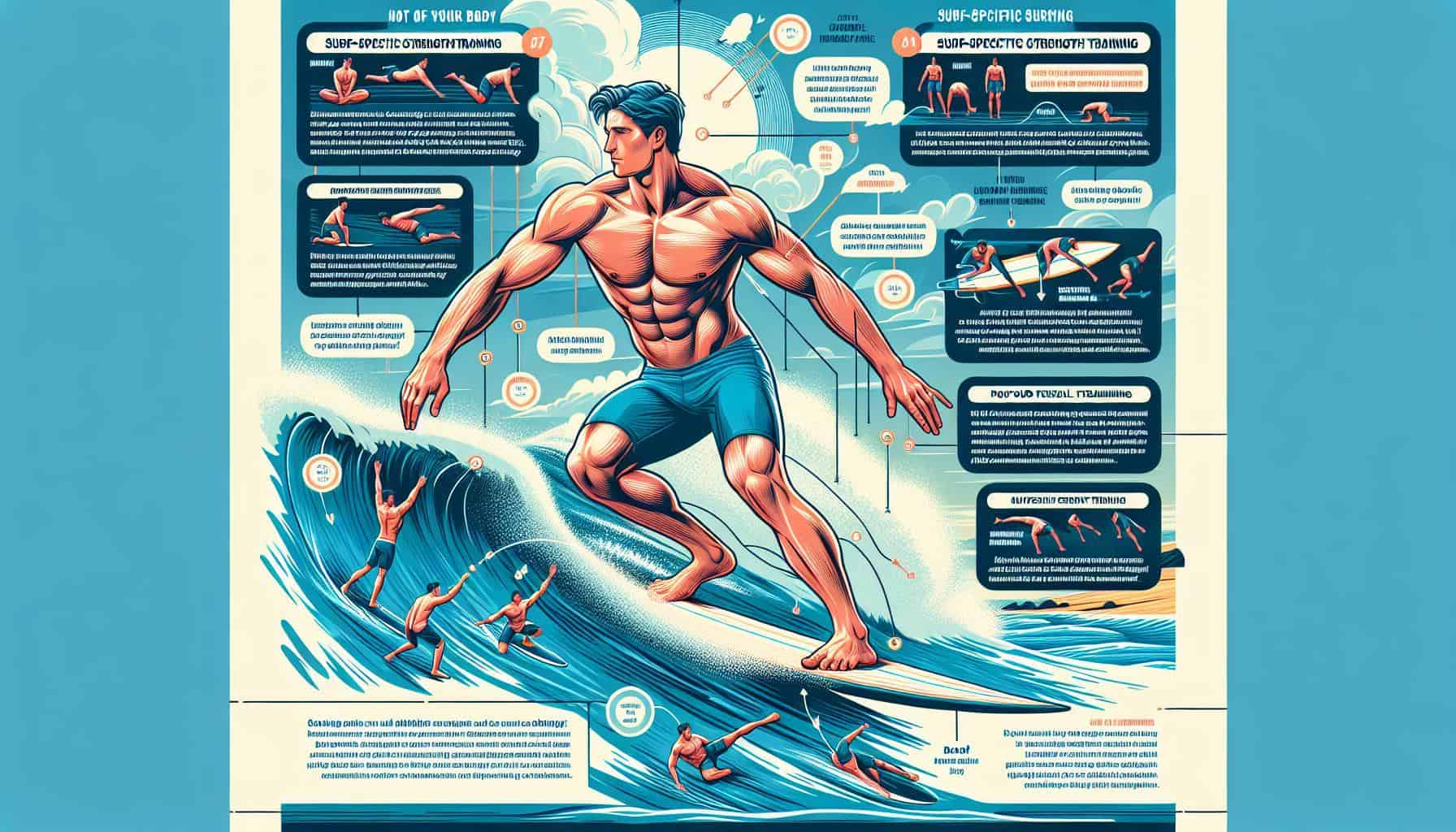 When you’re gearing up to take on the waves, strength training for surfing can take your skills to new heights. Surf-specific training is not just about bulking up; it’s designed to enhance your performance out on the ocean. This kind of training sharpens your abilities where it counts, ensuring that every paddle, pop-up, and carve is executed with the utmost precision and power.
When you’re gearing up to take on the waves, strength training for surfing can take your skills to new heights. Surf-specific training is not just about bulking up; it’s designed to enhance your performance out on the ocean. This kind of training sharpens your abilities where it counts, ensuring that every paddle, pop-up, and carve is executed with the utmost precision and power.
One of the primary benefits of strength training tailored for surfing is enhanced muscular control. With exercises that mimic the dynamic moves of surfing, your muscles learn to work together more effectively. The interplay between different muscle groups becomes smoother, allowing you to maintain balance on the board and respond swiftly to the shifting waters beneath you. This level of control is pivotal as it helps you avoid wipeouts and maintain your form even when faced with unpredictable swells.
Furthermore, surf-specific strength workouts can vastly improve endurance, especially in critical areas like the back, shoulders, and arms. With a routine focusing on these key muscle groups, you’ll be able to sustain longer sessions on the water without succumbing to fatigue. This is crucial because it’s not the number of waves you catch but how well you ride them that defines a successful surf.
Your core stability is another major player improved by surf-specific training. A strong core isn’t just about having a toned midsection—it’s the foundation of all your surfing movements. From standing up on the board to executing tight turns, a solid core ensures your body moves as one cohesive unit. That stability serves as your anchor against the force of the waves, keeping you upright and in control.
By investing time in surf-specific strength training, you’re not just preparing your body for the demands of the sport but also safeguarding it. Injury prevention is a byproduct of consistent and targeted training, reducing the risk of common issues that sideline many surfers. Strong, well-conditioned muscles act as protective shields for your joints and connective tissues, reinforcing your resilience against the physical toll surfing can exact.
Key Muscles to Target in Your Surf Strength Training Program
 When crafting your strength training for surfing routine, it’s essential to pinpoint the muscles that’ll offer you the greatest benefits. Focusing on key areas ensures that you’ll be ready to tackle the waves with increased power and reduced injury risk.
When crafting your strength training for surfing routine, it’s essential to pinpoint the muscles that’ll offer you the greatest benefits. Focusing on key areas ensures that you’ll be ready to tackle the waves with increased power and reduced injury risk.
Core strength is fundamental—not only does it provide stability, but it also helps to transfer force efficiently throughout your body. You’ll want to engage in exercises that challenge your abdominal and lower back muscles, aiding in those sharp turns and maintaining balance on your board.
Your lower body demands attention too. The muscles here—your quads, glutes, calves, and ankles—are responsible for explosive movements and long periods of endurance. Think about exercises that mimic the actions of surfing, like squats and lunges, to develop leg strength and power for those moments you need to pop up and ride the wave.
Let’s not forget about the upper body—particularly your upper back and shoulders which you use tirelessly while paddling. Without proper surf-specific strength training, your paddling efficiency could suffer, leaving you struggling to catch waves.
A solid aerobic and anaerobic energy system is necessary to sustain your efforts in the water. Including cardiovascular workouts will augment your stamina, allowing you to surf longer and more vigorously.
Lastly, the strength and mobility of your ankles and hips play a substantial role. These joints need to be flexible and functional to adjust to the unpredictability of the ocean. Mobility exercises and stretches are vital to avoid stiffness and maintain a good range of motion, a critical aspect of surfing performance.
Remember to incorporate a variety of movements that target these key areas. Not only do they improve your surfing ability, but they also contribute to overall muscle balance and joint health. Whether it’s dynamic stretches to start a session or focused strength workouts, all contribute to developing a more powerful and resilient surfing body. Enjoy the waves knowing your strength training has prepared you to make the most of every ride.
Exercises for Building Upper Body Strength
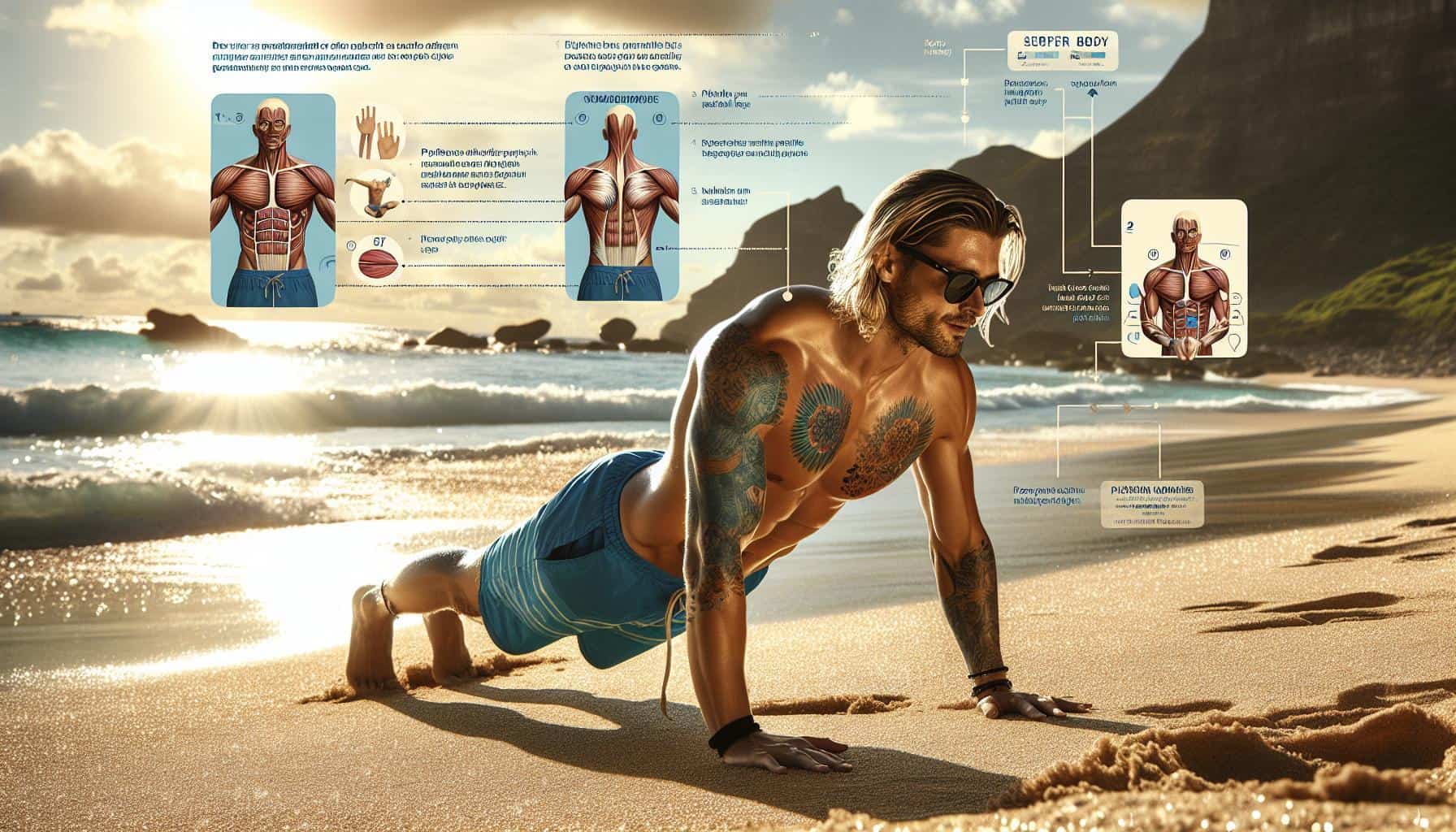 When you’re aiming to enhance your surfing prowess, strength training for surfing becomes pivotal. Remember, when paddling out to catch those waves, upper body resilience and power are your best friends.
When you’re aiming to enhance your surfing prowess, strength training for surfing becomes pivotal. Remember, when paddling out to catch those waves, upper body resilience and power are your best friends.
Pushups take the spotlight in this arena. Think of them as your multifunctional tool to target multiple muscle groups simultaneously, boosting not only upper body but also core strength. As you progress, aim for higher rep counts; start where you’re comfortable and push for 100, 200, or even 300 pushups. With each pushup, visualize the stroke of paddling. This isn’t just about brute force—it’s blending strength with muscle endurance.
Now it’s time to mix in a little variety. If your regular pushups start to feel less challenging, elevate your legs or, if you’re up for it, add some weight on your back. This isn’t just a boost to your upper body; it’s a strategic move to mimic the resistance you face while in the water.
Don’t forget the pull-up. It’s another exceptional exercise that leverages your body weight to escalate functional strength. The goal isn’t to pack on mass but to condition your body for the demands of surfing. Your upper back, shoulders, and core get a comprehensive workout, supporting those essential surfing maneuvers.
- Pushup Tips:
- Pull-up Advice:
A key point to remember is that any pushing movement recruits a combination of chest, shoulders, and triceps muscles. These are crucial for executing a proficient paddle and an explosive pop-up on your board.
Your training shouldn’t stop at just developing strength; muscle endurance is equally necessary. Strike that perfect balance to enhance your stamina without compromising your ability to fluidly navigate the waves. By committing to these exercises, you’re setting the stage for a strong, high-performing upper body which is essential in the world of surfing.
Strengthening the Core for Improved Stability
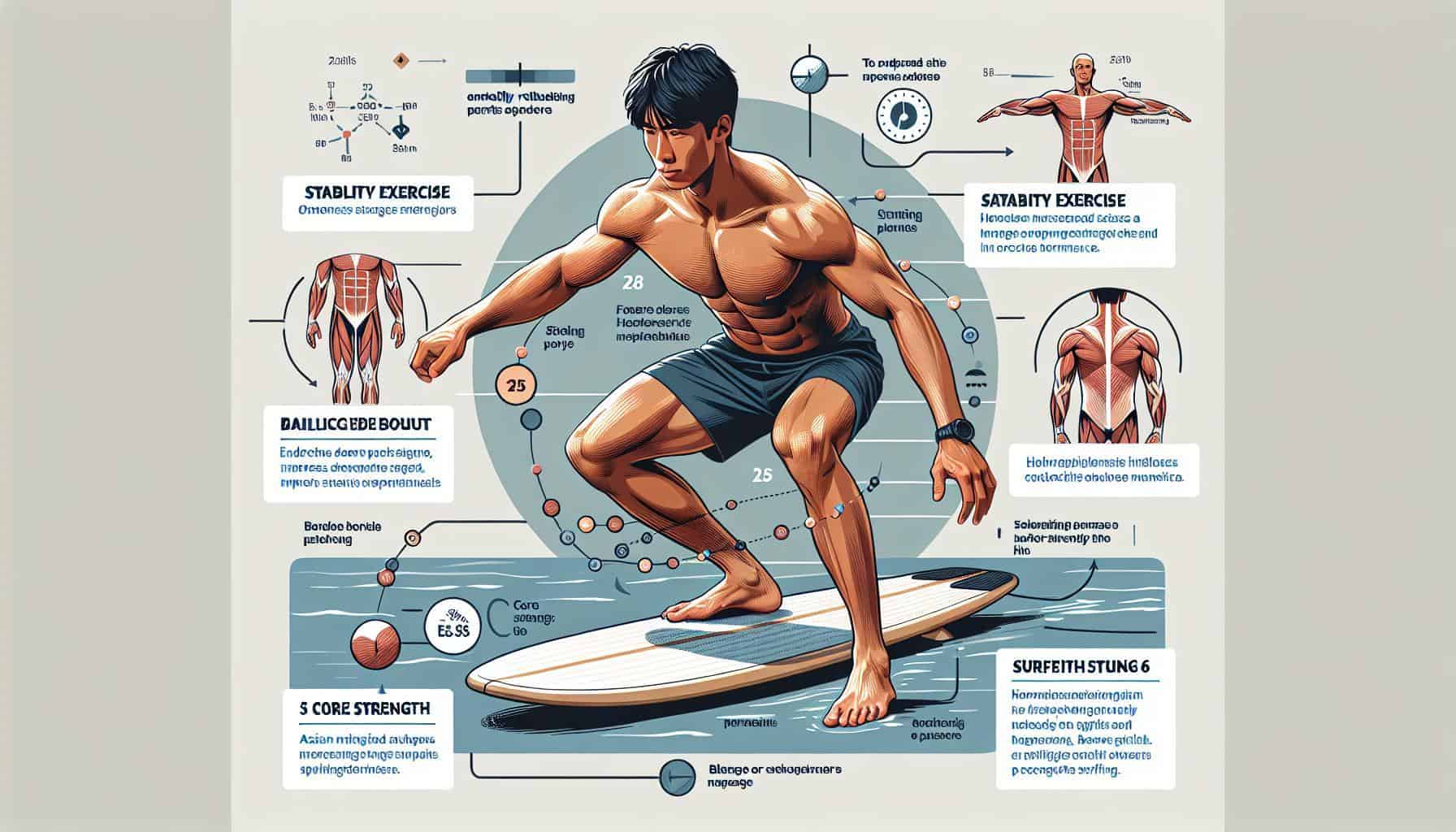 When you’re looking to improve your surfing performance, strengthening your core cannot be overstated. A powerful core is the bedrock of stability, balance, and efficient power transfer when you’re riding the waves. Remember, core training goes beyond basic crunches; it’s about whole-body integration.
When you’re looking to improve your surfing performance, strengthening your core cannot be overstated. A powerful core is the bedrock of stability, balance, and efficient power transfer when you’re riding the waves. Remember, core training goes beyond basic crunches; it’s about whole-body integration.
Realistic strength training for surfing involves integrating exercises that target your core’s multifaceted muscle group. Exercises such as deadlifts, squats, and snatches are paramount, offering more to your core than what’s widely perceived. These lifts, when done correctly, induce a high level of core engagement, which is essential for surfers who depend on their core strength to maintain balance and poise on unpredictable waters.
- Deadlifts
- Front Squats
- Back Squats
- Lunges
- Snatches
- Kettlebell Swings
All the above create a synergy that pushes your core strength to its limit, but you must learn to execute them properly. A qualified coach can be invaluable here, ensuring that you’re not only performing the movements safely but also reaping the full benefits for surfing.
Balance and stability drills are great for fine-tuning your core muscles. These include exercises that challenge your balance and necessitate core activation to maintain stability. Consider incorporating:
- Single-Leg Balance Drills (with upper body rotations)
- Medicine ball tosses while balancing
- Single-leg cable pushes or pulls
Training tools such as an Indo Board or Balance Board also make for an engaging way to work on your stability muscles, directly translating to better performance on a surfboard. Never overlook the value of single-leg exercises either:
- Bulgarian Split Squats
- Lunges
- Single-Leg Deadlifts
- Ice Skater Squats
- Single-Leg Box Squats
These targeted movements are extremely effective for not only building a sinewy core but also avoiding potential injuries and boosting your surfing agility. Through strategic strength training for surfing, you’ll find yourself catching waves with a newfound speed and power, all rooted in your stabilizing core.
Enhancing Lower Body Power and Agility
For surfers, having a strong and agile lower body isn’t just a bonus—it’s essential. Lower body power translates into explosive movements on the waves, and agility allows you to pivot and change directions in an instant. Strength training for surfing should, therefore, include exercises that condition your legs and hips for this dynamic environment.
When it comes to boosting your lower body prowess, you can’t overlook the basics. Squats and lunges are staples in surf fitness as they mimic the natural motion of surfing. By engaging your quads, glutes, and calves, these exercises promote muscular balance and power. Here’s how to leverage these moves for surfing:
- Perform deep squats to strengthen the chain of muscles used in a deep paddle or while popping up on the board.
- Lunges, on the other hand, are excellent for simulating the stance changes when you’re carving up the waves.
But don’t stop there. To increase lower body agility, you must also incorporate dynamic movements that challenge your balance and coordination. Jumping jacks, a seemingly simple exercise, are amazingly effective at this. Not only do they elevate your heart rate, preparing you for the intensity of surfing, but they also work to improve your ankle strength and mobility. These are vital in surfing as they absorb shocks and help maintain stability on unpredictable waters.
Incorporating plyometric exercises, like box jumps or hop-and-hold drills, can further enhance your lower body’s explosive strength. These high-energy movements develop your ability to launch off the water’s surface and land gracefully, with control—much like managing the waves.
Remember to align your movements with your breath, as synchronized breathing helps in executing movements with precision and fluidity. This attention to breath will serve you well when facing long paddle-outs or when you’re required to maintain calm under pressure.
By integrating these exercises into your routine, you’ll see noticeable improvements in your surfing performance. Your legs will be more equipped to handle the challenging demands of the sport, enabling you to ride with greater confidence and power.
Creating a Surf-Specific Workout Routine
Developing a surf-specific workout routine requires understanding the unique physical demands surfing places on your body. It’s not just about hitting the gym; it’s about crafting a regimen that reflects the multidimensional movement and dynamic strength needed to excel on the waves.
Start by pinpointing exercises that replicate the actions you perform in the water. Surfing requires powerful legs for quick pop-ups, agile turns, and solid stances; hence, lower body exercises should be a staple in your routine. As you’ve learned, squats and lunges are key for building the necessary leg strength. But beyond that, consider exercises that foster explosive leg power – think: box jumps and kettlebell swings.
Transition to upper body workouts that enhance your paddling power and endurance, indispensable for those long sessions in the surf. Push-ups and pull-ups enhance upper body strength, thus strengthening your ability to battle through the breakers and maintain control on your board.
A crucial aspect is core stability. Incorporate exercises like planks and medicine ball twists to build a core that can withstand the unpredictable nature of the ocean. Remember, a strong core is your foundation for every move you make in surfing.
Exercise | Reps | Sets | Rest (Seconds) |
|---|---|---|---|
Squats | 6-12 | 3-5 | 60-90 |
Lunges | 6-12 | 3-5 | 60-90 |
Box Jumps | 6-12 | 3-5 | 60-90 |
Kettlebell Swings | 6-12 | 3-5 | 60-90 |
Push-Ups | 6-12 | 3-5 | 60-90 |
Pull-Ups | 6-12 | 3-5 | 60-90 |
Planks | – | 3-5 | 60-90 |
Medicine Ball Twists | 6-12 | 3-5 |
Choosing the Right Equipment for Surf Strength Training
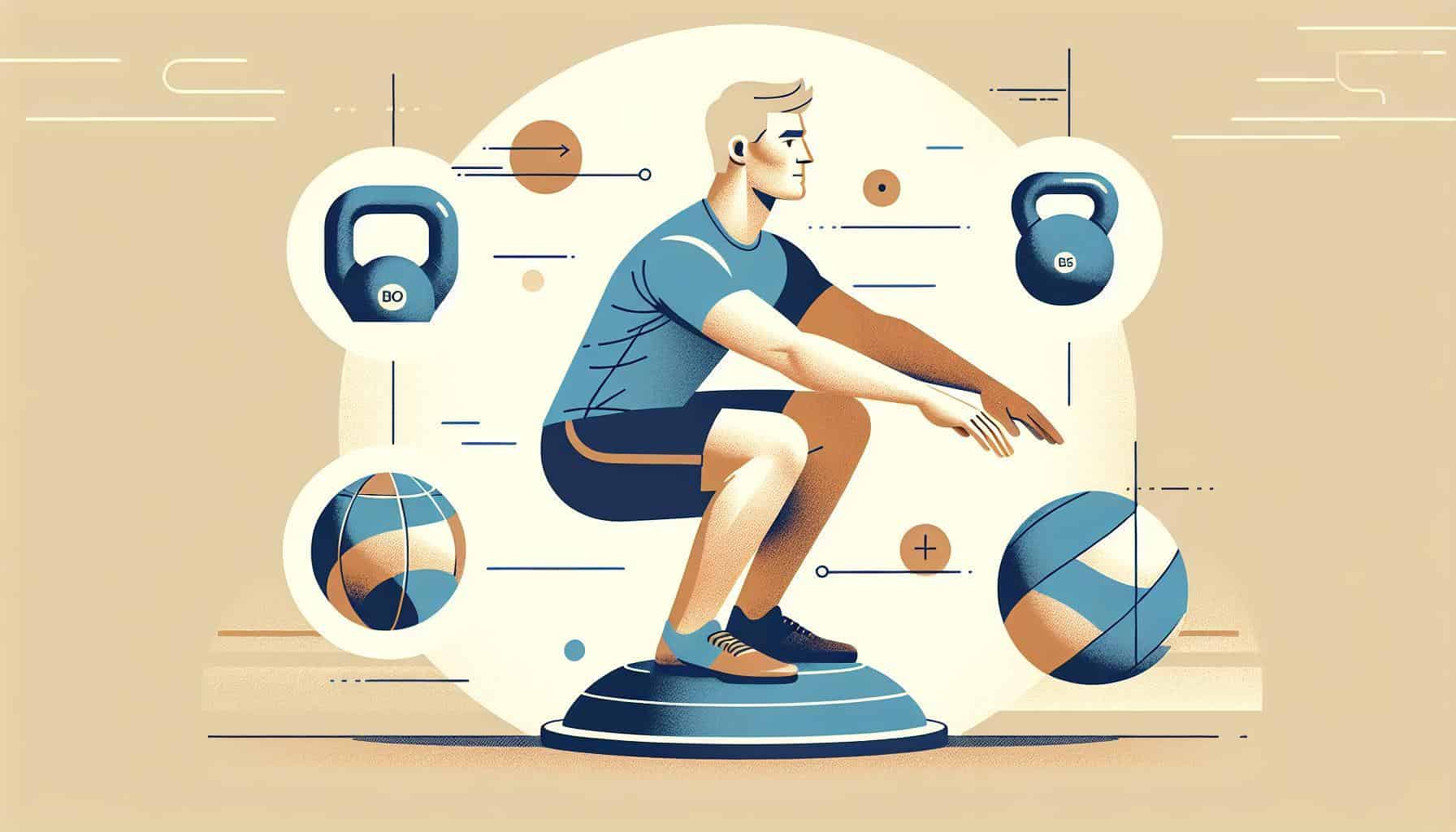 When you’re zeroing in on strength training for surfing, the equipment you choose can make a significant difference in your fitness journey. Your goal is to mimic surf scenarios to enhance your in-water performance, so selecting gear that supports functional movement is crucial. With the right tools by your side, you’ll be able to progress safely and efficiently, translating your hard work into palpable surfing prowess.
When you’re zeroing in on strength training for surfing, the equipment you choose can make a significant difference in your fitness journey. Your goal is to mimic surf scenarios to enhance your in-water performance, so selecting gear that supports functional movement is crucial. With the right tools by your side, you’ll be able to progress safely and efficiently, translating your hard work into palpable surfing prowess.
To kickstart your regimen, consider adding stability tools to your routine. Balance boards or Bosu balls provide an unstable surface, which forces your core to engage and stabilize–just like when you’re out on the water. It’s a clever way to simulate the constant adjustments your body makes while riding waves.
Next, remember that explosive leg strength and core stability are the mainstays of a surfer’s athleticism. For this, kettlebells and medicine balls are unmatched. These pieces of equipment can be used for dynamic workouts, facilitating moves that build power and agility. For instance, kettlebell swings and medicine ball slams are fantastic for cultivating that explosive energy necessary for popping up on your board.
For upper body and arm strength, conducive to powerful paddling, resistance bands can be a surfer’s best friend. They’re portable, versatile, and can effectively isolate and build muscle groups essential for surfing. Moving through resistance band routines can enhance your muscular endurance, allowing you to surf for longer periods without fatigue setting in.
In your pursuit for surf-specific strength, don’t overlook free weights like dumbbells and barbells. While traditional gym equipment might not seem surf-appropriate, exercises such as deadlifts and squats with these weights directly contribute to the lower body power you need.
Keep in mind:
- Your choice should mirror the multifaceted nature of surfing
- Exercise equipment must challenge balance, coordination, and strength
- Focus on gear that allows for both isolation and compound movements
With these considerations, your strength training for surfing equipment will provide a solid foundation for building a routine that’s as effective in the gym as it is in the surf.
Nutrition and Recovery for Optimal Performance
 While strength training for surfing is essential, your nutrition and recovery strategies are just as crucial for optimal performance on the waves. Eating the right foods and taking care of your body post-exercise play a pivotal role in how well you’ll tackle your next surfing session.
While strength training for surfing is essential, your nutrition and recovery strategies are just as crucial for optimal performance on the waves. Eating the right foods and taking care of your body post-exercise play a pivotal role in how well you’ll tackle your next surfing session.
Power Up with the Right Foods
For long sessions in the water, you need to fuel up properly. A blend of high-quality proteins, healthy fats, and nutrients is key. Start your day with a breakfast that includes protein, fruits or veggies, and sources of good fats like avocados or nuts. This combination provides sustained energy and aids muscle recovery.
Hydration and Rehydration
Stay hydrated by drinking clean water before, during, and after your surf sessions. Dehydration can lead to fatigue and decreased performance. Ditch sugary drinks for water with a squeeze of citrus fruit and a pinch of salt, an excellent drink for natural rehydration.
Post-Surf Nutrition
After you hit the waves, it’s vital to replenish your glycogen stores and repair muscles with fruits and a quality protein source. This duo helps kickstart recovery, ensuring you’re ready for your next challenge.
Smart Choices for Sustained Energy
Emphasize whole foods and eliminate processed foods and excess sugar from your diet. Such changes can have an immediate impact on how you feel and perform. Opt for meals that balance proteins, carbohydrates, and good fats to maintain energy levels throughout demanding surfing sessions.
Remember, the foods you consume act as the building blocks for your body’s recovery and overall health. Make smart choices and you’ll see the difference not just in your surfing, but in your everyday life. Keep in mind that nutrition is a component of a broader lifestyle that supports your passion for surfing. Your strength training for surfing and dietary habits should align to ensure you’re at your best on every wave.
Conclusion
Embracing the power of surf-specific strength training will elevate your performance and enjoyment of the waves like never before. Remember that your legs are your foundation, so give them the power and agility they need with targeted exercises. Balance and coordination are your allies, so challenge them regularly. Don’t forget that your equipment can be your coach, guiding your muscles toward surf-ready strength. And above all, nourish and hydrate your body to recover and prepare for the demands of the ocean. Align your nutrition with your training, and you’ll find the strength to ride the waves with confidence and skill. Now grab your board, hit the surf, and feel the difference strength training makes in your next session.
Frequently Asked Questions
What exercises are crucial for surf-specific strength training?
Lower body exercises like squats and lunges build essential power and agility for surfing. Incorporating dynamic movements, such as plyometric exercises, helps improve balance and coordination. Also, use of stability tools, kettlebells, medicine balls, and free weights enhances core stability and lower body strength.
Can surfing contribute to weight loss and reducing belly fat?
Yes, surfing can help you burn calories and body fat. The physical demands of surfing, blending strength training with cardiovascular exercise, can contribute to a fit and toned physique.
Is there an ideal physique required for surfing?
No, there is no ideal body type for surfing. Surfers of all shapes and sizes can excel in the sport by developing strength, agility, and balance tailored to their unique bodies.
What considerations should be made regarding weight for crowd surfing?
A good rule of thumb for crowd surfing is if you require more than two people to lift you comfortably, you might be too heavy for the activity. Safety should always be the priority.
What type of strength is essential for surfers?
Surfers need muscular strength and endurance, especially in the shoulders for paddling, thighs for popping up on the board, and stabilizer muscles for balance. Strength training should target these areas for improved performance in surfing.

